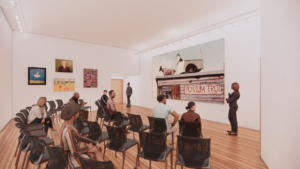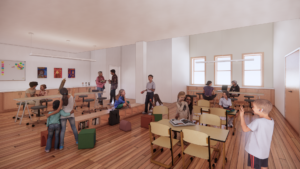“Museums absolutely can — and absolutely should — play a role in advancing social justice and change,” says Debra Kerr, president and CEO of Intuit: The Center for Intuitive and Outsider Art. “They are trusted sources of information. They’re also places where people with disparate perspectives and backgrounds can come together to dialogue.”
Kerr has promoted this vision for what museums can be throughout her 30-year career — most recently at Intuit, where she and her team shine a light on the work of artists who have faced barriers to the traditional art world.
Making change, however, isn’t easy; it requires the support and backing of strong partners. With that in mind, Kerr has seized every opportunity available to Intuit through IFF’s MacArthur Arts and Culture Loan (ACLF) program. Funded by the MacArthur Foundation and administered by IFF in partnership with BDO, Fifth Third Bank, and Restart Consulting, ACLF offers Chicagoland arts and culture organizations like Intuit four supports they can pick and choose from based on their needs: a line of credit, financial training workshops, expert technical assistance, and a Diversity, Equity, and Inclusion (DEI) Collective.
We sat down with Kerr to discuss Intuit’s experience with these program components. We also covered her definition of outsider art, Chicago’s rich history with the genre, and how Intuit is exploring ways to become as welcoming and accessible as possible through a new hybrid operating model.
IFF: For those unfamiliar with the genre, what is outsider art?
Kerr: There’s no set definition, but it generally means art by creators who are self-taught and could not take a traditional pathway to artmaking. According to Leslie Umberger, a curator at the Smithsonian American Art Museum who serves on Intuit’s Strategic Advisory Council, this is generally due to social barriers, such as race, gender, and class. I agree and would add geographic barriers because some people who make art in rural areas don’t have access to museums and art classes.
It’s a captivating genre. I see it as a very accessible form of art. Anyone can walk through the door at Intuit and recognize the themes and materials used to create this art and find relatable storylines and expressions in art made by people who have faced socioeconomic and political barriers.
IFF: Intuit is one of only a handful of museums in the world dedicated to outsider art. Why Chicago?
Kerr: There are outsider artists everywhere, but not all communities look for them and shine a spotlight on them the way Chicago has. Our city was one of the first places in the United States to accept outsider art as a legitimate genre.
It started in the early 1940s when the Arts Club of Chicago hosted an exhibition of the work of Horace Pippin, a self-taught artist of color. The Arts Club also hosted the French artist Jean Dubuffet, an early proponent of outsider art, in 1951 for a presentation on the genre.
Then, in the 1960s and 1970s, university professors like Ray Yoshida at the School of the Art Institute of Chicago and Don Baum at Roosevelt University started talking about this type of art with their students, encouraging them to go out into the community to find visually compelling objects.
Another milestone was in 1982, when the Corcoran Gallery in Washington, D.C., brought a show highlighting outsider American art to the Field Museum in Chicago. That exhibition ignited a lot of interest in the genre, and — about a decade later — a core group of artists, gallerists, and collectors came together to found Intuit.
IFF: That’s an incredible legacy. At what point in Intuit’s more recent history did you become aware of the ACLF program?
Kerr: It started with IFF, which had assisted Intuit early in its history, and though I was aware of IFF, I learned more about it when I joined Intuit in 2014. IFF’s mission resonated deeply with me, and we worked with Vickie Lakes-Battle to purchase the second floor of our building (which is a condo building) and refinance our mortgage on the first floor. Now, we have a single mortgage with IFF and a line of credit that IFF services. We tap that all the time.
Nonprofits need a line of credit to help handle what can be a very challenging cash flow cycle. You pay employees year-round, but a lot of money comes in at the end of the year when individual donors are responding to year-end campaigns. Plus, when we write grants at the beginning of the year, that money doesn’t show up until the second or third quarter. As a result, we experience some quarters that are bare, so having a line of credit to cover those periods is critical.
Overall, the partnership with IFF makes us a stronger, better, more prestigious institution. That relationship also led us to the ACLF.

Rendering of a future gallery space on the museum’s first floor. Image courtesy of Intuit: The Center for Intuitive and Outsider Art.
IFF: You’ve participated in the financial training workshops and technical assistance offered through ACLF. What were those experiences like for you and your team?
Kerr: We’ve participated in the training series twice. The first time was before the pandemic, around when we refinanced with IFF. More recently, a new set of Intuit staff members took the course. Like many nonprofit professionals, they didn’t formally study accounting, and they now have a shared and more thorough understanding of how nonprofit finance works.
The team has applied what they learned to communicate our financial picture to the board, as well. One of our perennial challenges is helping board members grasp the vagaries of nonprofit accounting. The training and one-on-one coaching we received from BDO armed the team with excellent tools that we can use: graphs, pie charts, and slides. BDO worked with the team to put together a “Fun with Finance” presentation that shows, at a glance, what is happening with our finances.
IFF: Is there anything else from the training series or the one-on-one coaching that stands out in your mind?
Kerr: It’s nice to be in a cohort with similar organizations. When I went through the training, Martha Nolin from the Chicago Youth Symphony Orchestra and Claire Rice from Arts Alliance Illinois were there. Being in the room with a cohort like that — and then having a coffee break and being able to chat about the issues you’re all facing — is helpful. Sometimes a little networking magic happens as well.
IFF: Let’s turn to the ACLF Diversity, Equity, and Inclusion (DEI) Collective. What drew you to that component of the program?
Kerr: The content of this museum means that there’s a great deal of dialogue around the fact that many of our featured creators are people of color, yet the majority of our founders and board members are white, like me. They grew to love this art by collecting art frequently made by Black and Brown artists, but we have to be sensitive to the potential for white savior issues.
We had begun to address this and other DEI issues by the time we got into the Collective. Our staff is ahead of our board in terms of their day-to-day sensitivity to DEI issues, which I found to be a common theme among nonprofits in the Collective. We follow basic best practices, like using MBE [Minority Business Enterprise] vendors, and we have a program to provide internships to emerging museum professionals of color (as two examples of the work we’d already started on our own).
Still, it’s important to recognize that we’re not there, yet — that we’ll be a work in progress for the rest of our lives — and the Collective focused heavily on self-reflection. We worked in small groups, enjoyed meeting people from other organizations, and discovered many similar shared experiences. I might have preferred a more tactical approach, but I always appreciate opportunities to learn — especially for my team, because we just don’t have a big professional development budget for them. Also, the Collective’s facilitator was great. She created a welcoming, empathetic space and provided helpful resources.
IFF: What opportunities do you see ahead for Intuit?
Kerr: I’ve always been interested in exploring what the new model for a modern museum can be. One of the key things the pandemic did was break down outdated expectations. We’ve been able to say, “We can’t do any of those things the old way anymore. We have to find new ways.” Our attitude now is: What can we experiment with, and what can we do differently?
That has freed us up to build on some of the changes we made during the pandemic. Since our audience is global, they were motivated to get online with us. In some ways, that has brought our members closer. They felt how important they are to us and recognized that Intuit is their museum, no matter where they live. So, we started offering online programming right away — I facilitated an artmaking workshop from my kitchen within a week after we closed our doors — and we continue to test online programs. One series that has been a success allows Intuit members to view private collections in people’s homes over Zoom. We hire a videographer in the collector’s town and show a 30-minute video of them leading a tour of their collection, then take questions from the audience. People love it!
For the in-person side of our hybrid operations, we’ve been able to maintain the more compressed schedule from the pandemic (we’re open Thursday through Sunday and by appointment on Tuesday and Wednesday). That’s working well for us because we don’t rely heavily on revenue from ticket sales. Instead, we offer a $5 admission fee and a “pay what you can” public program fee, which is part of our aim to be the most welcoming museum you ever walked into. The guest services team greets every guest when they come in the door and orients them to the art if they aren’t familiar with it. Also, if community members want to have a cup of coffee, watch a film about outsider art, and chat, they can. So far, the only negative feedback was that we needed to provide more chairs — which we did!
Last but not least, we recently received a $5 million grant from the City of Chicago to renovate our facility, and we’ll be working with IFF on a bridge loan to support the gaps as we receive campaign pledges. The project will add two additional gallery spaces, a dedicated education studio space, an updated exhibition on the celebrated artist Henry Darger, and much more.
It’s really exciting to have this big project on the horizon—and to know that we have the support of the ACLF program as we move forward.

Rendering of future Mr. Imagination education studio on the museum’s first floor. Image courtesy Intuit: The Center for Intuitive and Outsider Art